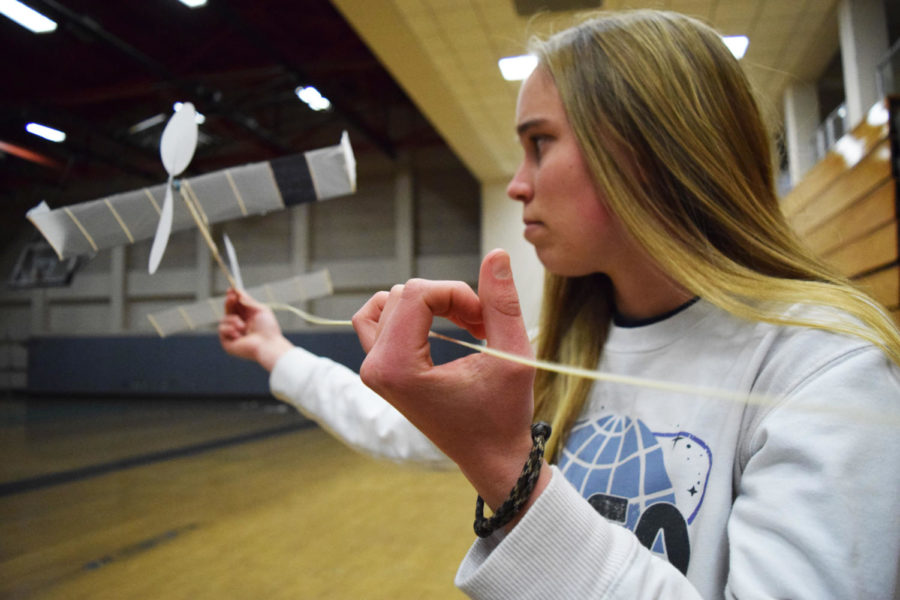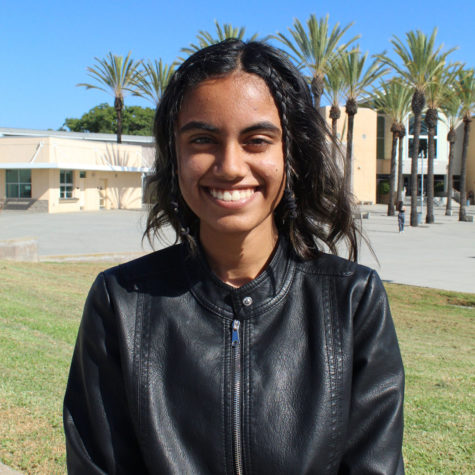Ellegaards pass on passion for Science Olympiad
April 7, 2023

When stepping into the Ellegaard home, one is greeted by an intricate, handmade marble ball track lining the staircase, Legos sprawled across the living room floor, and a woodshop in the garage, home to Science Olympiad practices.
Emilia Ellegaard’s (12) parents were always hands-on, opting to self-renovate their home with the help of nothing more than YouTube videos. They redid their cabinets, flooring, and the entire backyard. Almost naturally, Emilia fell in love with building at a young age. And as she observed her older brother Niklas Ellegaard (’21) constructing model planes, she found her own calling to craft.
In sixth grade, she joined Mesa Verde’s Science Olympiad team. Throughout her three years there, she competed in Experimental Design, an event where participants design, conduct, and report the findings of an experiment based off a given prompt; Wright Stuff, an event where participants build a wooden plane to compete for the longest flight time; and Road Scholar, where participants learn about topography and interpret various types of maps.
“My core memories [in middle school Science Olympiad] wasn’t how I placed, but the joy I had afterwards,” Emilia said. “I distinctly remember how after Experimental Design, I thought we failed, and getting into the awards ceremony, I realized everyone felt that way. [I also recall] having a great flight [in Wright Stuff] and sharing those happy moments with my partner.”
Emilia said she fondly recollects the regional and state competitions with her middle-school team as days packed with emotions of frustration and joy, nervousness and excitement.
“I like how obscure certain topics in Science Olympiad are,” she said. “[I like] how you can analyze one thing and learn really deeply about that, because in school, we kind of go surface-level on a lot of concepts.”
She then joined Westview’s Science Olympiad team as a freshman, but COVID-19 posed challenges in competing.
Virtual Science Olympiad competitions are satellite competitions, where participants either have Zoom-ed in or completed a test using an online software.
One event she participated in virtually was Write It CAD It, where one partner writes a description of an object and how to build it, while the other partner uses that description to construct the object with a computer-aided design (CAD) software. Emilia’s partner was her older brother, Niklas.
“We had just learned how to use the software a couple of days before and then we were rushed into competition,” Emilia said. “I remember my brother was downstairs writing and I was the person assembling. It didn’t quite feel like a normal competition, and that’s what disappointed me the most.”
Despite the altered competition format, Emilia persisted, especially in the event Wright Stuff.
During regionals last year, Emilia held up the plane she had built with partner Parsa Pourghasem (11) to the camera, using a ruler to confirm that the measurements abided by the requirements. As she launched the plane, a fellow competitor had the computer in hand, angling the screen to allow the judges to observe the flight.
The plane hit a rafter at the top of Westview’s gym, nearly getting stuck. Emilia and Pourghasem watched in anticipation as it bounced over, continuing its flight. On-lookers rushed into the gym, watching the plane make its descent.
At 3 minutes and 13 seconds, Emilia and Pourghasem had set the school record for the longest flight time.
“I was shocked,” Emilia said. “We weren’t expecting [to set the school record], but we were overjoyed by the flight time.”
Emilia and Pourghasem placed first in Wright Stuff at regionals. Westview had placed second overall. They were going to the state competition, held virtually at Black Mountain Middle School. There, the two faced another set of hurdles.
“They have a hole in the middle of the ceiling,” Emilia said. “We had a constant drift— the plane would fly and be perfect, but then it would hit a pocket of air and drop down. We ended up changing our launching technique there, winding the plane up as much as we could and dropping it from a height [as opposed to lower] to allow it to go down and stall. It was a very interesting technique.”
Westview placed 11th at states overall, with Emilia and Pourghasem placing third in Wright Stuff.
With six years of Wright Stuff (now known as Flight) experience under her belt, Emilia headed into her final season. This year, she not only competed, but coached two events— Trajectory and It’s About Time.
“After so many years of competing, I have the ability to be confident in my decisions and make changes on the fly,” Emilia said. “I know I have the ability to adjust anything that happens in the competition, and I’ve also built my own designs now [for various wing types].”
Upon Emilia’s encouragement, her younger brother Tomi Ellegaard (9), joined Westview’s Science Olympiad team as well.
“Emilia helped me in the majority of my events,” Tomi said. “She helped me understand how the machine in It’s About Time works, and she helped me build in both of my events.”
In regionals this year, the first in-person competition in three years, Westview placed fourth overall. Out of the 55 total teams in regionals, the top seven advanced to states.
In Flight specifically, Tomi placed first with Emilia placing second. She also placed first in WiFi Lab, and fourth in both Trajectory and It’s About Time.
Emilia and Tomi’s dad, Peter Ellegaard, has been involved with Science Olympiad throughout their years in the program, working with them throughout the process of constructing model planes and occasionally coaching a few events.
“My dad and I calibrated a 3D printer together to help Tomi with the timekeeping device in It’s About Time,” Emilia said. “In Flight, he helped advise us in the initial steps as well.”
With both his sister and his dad’s guidance, Tomi became enraptured by Science Olympiad—now, he too is eager to pursue it in high school.
“Science Olympiad was just a really good experience,” Tomi said. “Although I wasn’t really looking forward to it this year, I really want to do it now.”
The state competition will be held tomorrow at the California Institute of Technology.
Emilia and Pourghasem have been preparing by making slight modifications to their plane.
“Our plane is pretty set, and now, we’re just changing the flight characteristics a little bit,” Emilia said. “We’re making it have a larger diameter in its rotation, and we’re experimenting with changing motors. And I’m actually using my [younger] brother’s old plane so that we’ll have two in case one crashes on the day of the event.”
For the last six months, Emilia and Pourghasem have been practicing in the Mesa Verde gym for hours on Thursday and Friday afternoons. They time practice flights, fine-tune the motor, and experiment with various launching techniques.
Although the season is coming to a close, Emilia is grateful for the opportunities she’s had in Science Olympiad. Next year, she hopes to pursue aerospace engineering in college.
“I’ve loved the hands-on component and the ability to see what you can change to have certain effects [on a plane],” Emilia said. “This is what I could possibly be doing in the future. Science Olympiad kind of compelled me to see what I can do further in aerospace engineering.”
She’s also eager to see what the organization has in store for Tomi.
“I’m definitely excited for him,” Emilia said. “Of course, he has different interests than me. So next year, maybe he will be doing completely different events. But hopefully, I inspire him to find his passion, because that’s kind of how it worked for me. I found my passion through science.”
For Emilia, competing one last time will be bittersweet. At the same time, she said she’s ready to move onwards.
“Although I won’t be competing in Science Olympiad in the future, I want to see what other things I can get into,” Emilia said. “But I know I’ll definitely be back here in the gym, helping bring ideas to my brother.”


